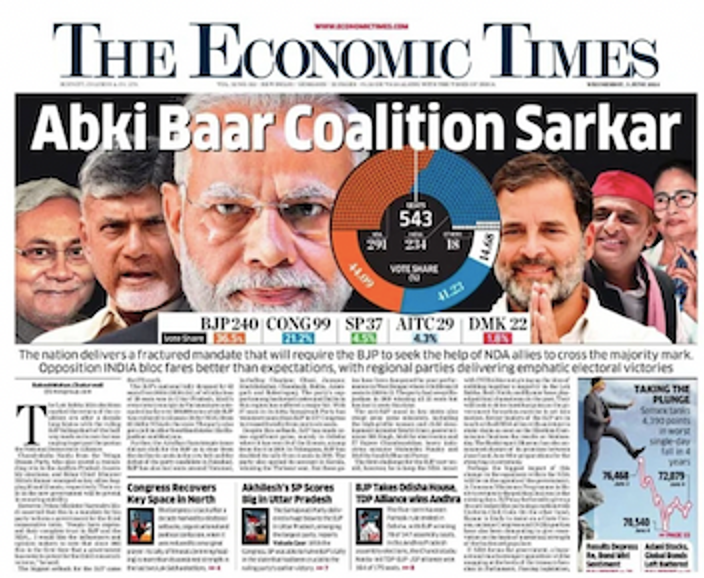BEST BEFORE: Your guide to the Indian general election’s surprise result
by Treya Agarwal | June 13, 2024

“How many seats do you think Modi will get? 300 for sure?”
At a dinner-table conversation a few weeks ago, two friends and I were placing our bets on how many seats in the Lok Sabha the Bharatiya Janata Party (BJP) – the right wing, Hindu-focused party led by Narendra Modi – alone would get. My friend cautiously said, around 300-310 (of 543); I confidently declared that I was sure they would get at least 340; far surpassing the number required for a clear majority and gaining a historic ‘landslide’ victory. The party themselves boasted what they thought would be guaranteed landslide election results; on occasion arrogantly suggesting, they would cross 400 with their ‘Chaar Sau Paar’ assertions. Suffice to say, none of this happened. For the first time in a decade, Modi and the BJP did not win a clear majority and had to rely on allies to form the government.
News outlets, exit poll predictions, polling companies, surveys, and the public were collectively shocked. A week before the elections, Home Minister and BJP top official, Amit Shah, said that the BJP were “comfortably at 300-310”. He was not alone; the Axis My India exit poll on June 3rd predicted huge wins for the NDA, projecting that the alliance would win as much as 360 to 400 seats. Chanakya, another polling organization, suggested that the 400-seat mark would even be surpassed. One factor was the widespread popularity the BJP has enjoyed in the last decade; in 2019 they won 303 seats, about what they got with allies this time, and in 2014 they won 282 – the first time any single party had won a straight majority since 1984. Modi himself has enjoyed high approval ratings for most of his tenure.

Image credit: Faye D’Souza, Beatroot News
The Indian General Election works such that each state has a certain number of constituencies, each who elect a Member of Parliament (MP) to the Lok Sabha (lower house of the Parliament). There is a total of 543 seats; each one uses a first-past-the-post voting system to decide on the winner, a legacy of India’s colonial past. In 2019, this system saw 37 parties enter the Lok Sabha elections, challenging the claim that FPTP generally produces a two-party system. This year, 642 million voters participated in the election, with 312 million women – making it the highest participation of women voters in Indian history.
The dominant parties that have historically garnered the most seats in national elections are the BJP and the Congress. Outright majorities in the Lok Sabha used to be rare, and if any single party does not get a direct majority, coalitions are necessary to form governments; this is when parties agree to work together to reach the required 272 number to form a government. Since there are few major national parties, and they are usually on opposite sides, coalitions are often formed along with state-level parties (who can contest seats in the General Election). However, in 2014, for the first time in almost three decades, the BJP won a clear majority and formed the government. They repeated the feat in 2019 with an even wider majority.
Part of the reason behind widespread pro-BJP predictions has the significant decline in electoral freedoms in the lead up to this general election (and Modi’s tenure as a whole). In March, prominent opposition were arrested with corruption charges – notable amongst these was Arvind Kejriwal, who ran for Prime Minister in 2014, and is the Chief Minister of Delhi, and Hemant Soren, Chief Minister of Jharkhand. The arrests were over ‘corruption’ charges; Kejriwal denied any wrongdoing and said the case was ‘politically motivated’. Rahul Gandhi, face of the Congress (descendant of Nehru) was arrested last year over “criminal libel”; this came after Gandhi’s extremely successful voter outreach program: ‘Bharat Jodo Yatras’ (roughly translated: Indian Unity Walk) – a six-month long, 6,713-kilometer journey from the southern tip to the northern regions of India, and a second walk from the eastern regions to Mumbai in the West. These examples of direct opposition party suppression make the result even more surprising.
The opposition alliance, I.N.D.I.A got 234 seats, far more than anyone could have predicted; the main opposition party, Congress (famous historically for being the party of Mahatma Gandhi, Jawaharlal Nehru, and the freedom movement) alone got 99. Given the atmosphere of censorship, hostility, and suppression of opposition candidates, as well as the prevailing feeling of their popularity, this is a massive setback for Modi. The surprise result has spawned a renewal of faith in democracy: the Wire wrote that the results is “the collective win of millions” and that Modi will “never again” be able to “impose his malevolent will on India” as he has in the past decade. Notably, the uncertainty and surprise results caused a significant impact on the stock market: the NIFTY index closed 5.7% lower, and Indian shares posted their worst session in more than four years. Analysts raised concerns that although the Modi government will return, the slimmer majority has raised some concern about continuity of the policy agenda and macro stability. Modi’s fiscal policy has largely touted the remarkable economic growth the country has seen post-covid, and the increase in trade with other countries.
Notably, Modi will be forced to form a coalition government, for the first time in over a decade, which constrains his ability to enact policy entirely according to the BJP’s goals and forces him to rely on allies in the National Democratic Alliance (NDA). Key allies such as Andhra Pradesh’s Telugu Desam Party (TDP) led by Chandrababu Naidu, and Bihar’s JD(U) led by Nitish Kumar, which won 16 and 12 seats and are required to form the majority. They were also former allies of the opposition alliance, making them extremely important and improving their bargaining position, constraining Modi’s ability to enact policy unilaterally. As it stands, after a few days of uncertainty, his allies have backed him and he was sworn in on Sunday, 9th June, as Prime Minister for the third time, despite the major setbacks. He is only the second person in India’s history to have achieved this feat, the first being Jawaharlal Nehru, the first Prime Minister and a key leader in the freedom struggle against the British Raj. The Economic Times front cover on the day of the election reflected the aggregated and coalitional nature of the results. Notably, had the Opposition managed to get the former allies TDP and JD(U) – leaders pictured below to the left of Modi – to switch sides, they could have ousted the BJP and Modi as Prime Minister.

Image credit: The Quint
So, who are the touted opposition who managed to shake the BJP up? The Indian National Development Inclusive Alliance (I.N.D.I.A), formed in 2023, is a big-tent party political alliance, led by the biggest opposition party, the Congress. The coalition developed out of a growing frustration with the BJP’s continued rule, bringing various regional and state level parties together; they met multiple times over the course of July and August 2023, adding parties as they went. The bloc held its first event on the 22nd of December 2023, protesting the suspension of opposition MPs under the banner of “Save Democracy”; their first joint rally was held in Bihar on 3rd March 2024. In the election, they secured 234 seats, outperforming everyone’s expectations. The Congress alone got 99, making it the Official Opposition Party (that with the second highest number of votes) for the first time in a decade. The bloc is made up of key regional parties that each have a strong presence in their state and have been vocal about opposing the BJP. Notable examples include the All-India Trinamool Congress from West Bengal, led by Mamata Bannerjee (far right in above frame) and the Samajwadi Party from Uttar Pradesh led by Akhilesh Yadav.
One of the key surprises was the state of Uttar Pradesh; being the country’s most populous with 240 million residents, it is often key in an election with a total of 80 seats up for grabs. In 2019, the NDA won 64 seats, with the BJP alone winning 62; Congress only won 1 seat, and the Bahujan Samaj Party (BSP) won 10, and the Samajwadi Party (SP) got 5. However, in 2024, the SP got 37 seats, and the Congress 6, making that 43 for the INDIA alliance. In a moment almost cinematically resounding, the BJP lost the seat in Faizabad, in the Ayodhya region of Uttar Pradesh. This region became infamous as first the site of the demolition by a Hindu mob of the medieval Babri masjid (mosque) in 1992, which led to widespread communal riots, following by a very public court case that reallocated the land for the construction of a Ram mandir (temple). In January, Modi inaugurated the opening of this temple, which was seen as a key electoral benefit for the BJP’s Hindutva agenda. And yet, despite the forced court ruling, demolitions and pomp-filled inauguration, the seat was lost to the Samajwadi Party, a proponent of caste-based social justice, with a history of banking on Muslim minorities and the Hindu Yadav community (classified as a ‘backward caste’) for its leadership. In Modi’s own constituency of Varanasi, he won only by 150,000 votes – down from his 2019 margin of nearly 480,000. In contrast, Rahul Gandhi, the face of the Congress, won by 390,000 votes in Rae Bareilly. Even more satisfyingly, the BJP suffered a crushing defeat in the Banswara constituency of Rajasthan, where on 21st April, Modi gave a speech referring to Muslims as ‘infiltrators’, insinuating that the community is attempting to take over the country as with ‘high birth rates’, lending weight to dangerous and Islamophobic rhetoric.
These results are even more notable given the sinister background of corruption and election-influencing the BJP has been carrying out – from party funding to election oversight, to media, they have exerted their undue influence everywhere. In terms of funding, the government introduced an ‘electoral bonds’ scheme in 2018, allegedly to make party funding more transparent. However, it did the opposite, donors could buy the bonds in fixed denominations – from branches of the SBI (a government-run bank) and give them to political parties to be cashed. In its February order, the Supreme Court had directed the SBI not to issue any more such bonds, to provide details of those who bought them, and to give information about bonds redeemed by each political party to the Election Commission by 6 March.
Further, in March, Election Commissioner Arjun Goel resigned from his post in a surprise move, right before the Lok Sabha elections were to begin. The Election Commission of India, which oversees the process and fairness of elections in the country, is headed by three people; one of whom had already resigned previously. Given this, there was then only one EC on the board weeks before the mammoth general election. Two were hastily appointed by the government. One notable move that preceded Mr Goel’s resignation was the enactment of a new law late last year, in the absence of opposition, and substantive debate, altered the process of appointing the country’s top election officers. Under the revised procedure, the Chief Justice of India was excluded from the selection process, providing the executive a two third voting majority, further encroaching upon checks and balances to executive control.
Media control and coercion has also intensified during Modi’s regime. The government – and many BJP-controlled state administrations – have also sought to intimidate journalists using sedition and national security laws. In February, the government carried out ‘raids’ in the BBC India office as a reaction to a documentary released examining the 2002 Hindu-Muslim riots in Gujarat, where Modi was Chief Minister at the time. Siddique Kappan, journalist from Kerala, was charged with sedition for covering a story of a 19-year-old Dalit girl who was raped by four men. Dhaval Patel, editor of a Gujarati news website, was charged with sedition for writing an article critical of the state government’s Covid policy. In 2021, Kishorechandra Wangkhem was charged under the National Security Act by the BJP-led Manipur government for writing that cow dung does not cure Covid; he spent two months in jail. In 2020, India’s ministry of information and broadcasting blocked the television channel Media One for 48 hours because it had covered mob attacks on Muslims in Delhi “in a way that seemed critical toward Delhi police and RSS”. The RSS is a paramilitary Hindu-nationalist movement with close ties to Modi and the BJP and a dark history; it was explicitly inspired by the SS training methods, and one of its members shot Mahatma Gandhi in 1949. When the huge farmers’ protests broke out in Delhi against agricultural laws in 2021, prominent journalists from the Wire and the Caravan were charged with sedition for covering the death of one of the farmers. Even more chillingly, journalist Gauri Lankesh was shot dead in her Bangalore home by three assailants. While Western governments lecturing other nations about freedom and liberty is often an unedifying sight, many fear the silence of London and Washington “could pave the way for more ‘brazen’ action… by the Modi government” in the face of India as the geopolitical counterweight to China.
In the face of the extreme consolidation of power, media repression, and outright opposition suppression tactics used by the BJP, the surprise result is a testament to the power of the voter and frustration with the BJP’s current policy approach; if, despite all the propaganda, particularly the heightening of communally charged speech, they got less seats than they had in a decade. After the results, the BJP Instagram posted this graphic:

Image credit: Instagram @bjp4india
Modi also tweeted that the third-time NDA victory was a “historical feat in the history of India”. None of the BJP communication so far has mentioned the drastic surprise of results, Uttar Pradesh result, Ayodhya, Ram, or fall in votes from the 303 in 2019. Show of strength, denial, internal panic, or all the above?
At the INDIA post-election conference on June 5th, Congress President Mallikarjun Kharge said that the general election was a “huge political loss” for Modi, showing that the mandate is “clearly against him, the substance, and style of his politics” as well as being a “moral defeat”. One can only wonder if the country echoes his sentiments.∎

Words by Treya Agarwal. Graphic by Alice Robey-Cave.




